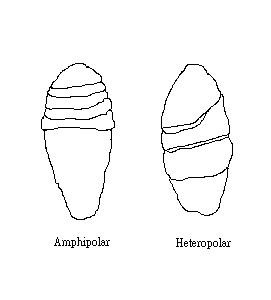
Another criterion used by some authors is based solely on chemical
composition. Fossilized feces are usually enriched in calcium phosphate (due
to phosphatization of the soft and/or hard parts of the fossil) and sometimes
more rarely organic matter.
Alternatively, some authors have used morphology as a classification system. For example, Neumayer in 1904 and Williams in 1972, described spiral
coprolites as amphipolar and heteropolar. Amphipolar coprolites show closely
spaced coils concentrated at one end only, while heteropolar coprolites show
more evenly spaced coils along the entire length of the specimen.

Nevertheless even these systems are not perfect when trying to classify coprolites. Form and composition can be severely altered during diagenetic processes (the biological, physical, and mechanical changes made to the host rock and fossil assemblage), thus making identification very difficult, if not impossible.
| Back |  |